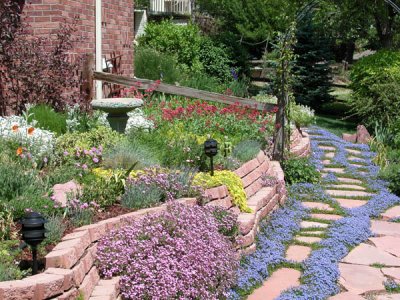Xeriscaping is a systematic method of promoting water conservation in landscaped areas.
Xeriscaping is mostly used in arid regions, but its principles can be used
in any region to help conserve water. The key principles of xeriscaping
are:
Planning and design
Provides direction and guidance, mapping your water and energy conservation
strategies, both of which will be dependent upon your regional climate
and microclimate.
Selecting and zoning plants appropriately
Bases your plant selections and locations on those that will flourish
in your regional climate and microclimate.
Limiting turf areas
Reduces the use of bluegrass turf, which usually requires a lot of supplemental
watering.
Improving the soil
Enables soil to better absorb water and to encourage deeper roots.
Irrigating efficiently
Encourages using the irrigation method that waters plants in each area
most efficiently.
Using mulches
Keeps plant roots cool, minimizes evaporation, prevents soil from crusting,
and reduces weed growth.
Maintaining the landscape
Keeps plants healthy through weeding, pruning, fertilizing, and controlling
pests.
The word Xeriscaping was coined by combining xeros (Greek for "dry") with
landscape. Plants whose natural requirements are appropriate to the local
climate are emphasized, and care is taken to avoid losing water to evaporation
and run-off. Some common plants used in xeriscaping are agave, cactus, lavender,
juniper, sedum and thyme.
Implementation
Implementation of xeriscaping includes:
Appropriate choice and arrangement of a plant (or plants) - where
possible, plants that are native to the area or to similar climates,
as well as other plants that tolerate or avoid water stress (xerophytes,
halophytes, summer-dormant bulbs, very deeply rooted plants) as ornamentals.
Hydrozoning, grouping plants with similar watering requirements together
is quite neccesary. Plants that require more water (for example, vegetables,
fruits, and certain flowers) are grouped together. These less water-efficient
plants may also be sheltered from the wind and/or sun by planting them
in the shade (under trees, beside a house etc.) to decrease the amount
of water they need.
Minimal turf areas, using drought-tolerant turf-grass species where
turf is needed at all (children's play areas). The landscape can be
filled in with borders and islands of more water-efficient ornamental
plants.
Efficient application of water - drip irrigation where possible. Overhead
irrigation (where needed) is applied in the morning or evening, when
it is less likely to be blown away by wind or lost by evaporation. Drought-tolerant
plants get no more water than they need to look good, and of course
water is not allowed to splash onto concrete walkways or other areas
where it is not needed.
Conservation of water in the soil. Soil with improved structure retains
water better, and mulch cools the soil surface and hinders evaporation.
Advantages
Lower water bills
More water available for other uses and other people (such as showers,
sinks, hoses)
Less time and work needed for maintenance, making your day simple
and relieving stress
Little or no lawn mowing (which saves gas)
Xeriscape plants along with proper bed design tends to take full advantage
of rainfall
When water restrictions are implemented, xeriscape plants will tend
to survive, while more traditional plants may not
Increased habitat for native bees, butterflies, and other fauna
Disadvantages
Requires planning, especially if color is desired throughout the
season, as most perennials do not bloom continuously
May require more start-up work to prepare beds for planting than simply
laying sod
Some homeowners' associations may object to non-traditional plants.
However, some states, such as Florida, include law, as it pertains to
Homeowner's Associations, that make it unlawful to include a clause
prohibiting "property owner from implementing Xeriscape or Florida-friendly
landscape, as defined in s. 373.185(1), on his or her land." in Homeowner
Association documents, (Ref: 720.3075.4 Prohibited clauses in association
documents)
Requires that people moving from water-abundant to water-scarce areas
change their mindset as to what types of plants they are able to practically
and economically maintain
May have to substitute one type of plant for another
Xeriscape beds require periodic maintenance which is more involved
than simply mowing and edging, especially to maintain color. Weeds and
trash may also be more of a problem than in a traditional lawn.
More complicated irrigation systems may be required
Xeriscape plants can waste water if irrigation is not properly managed

